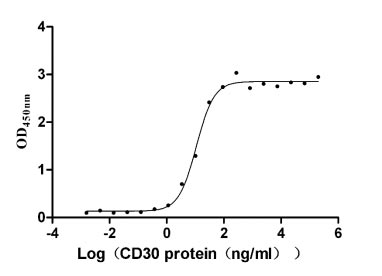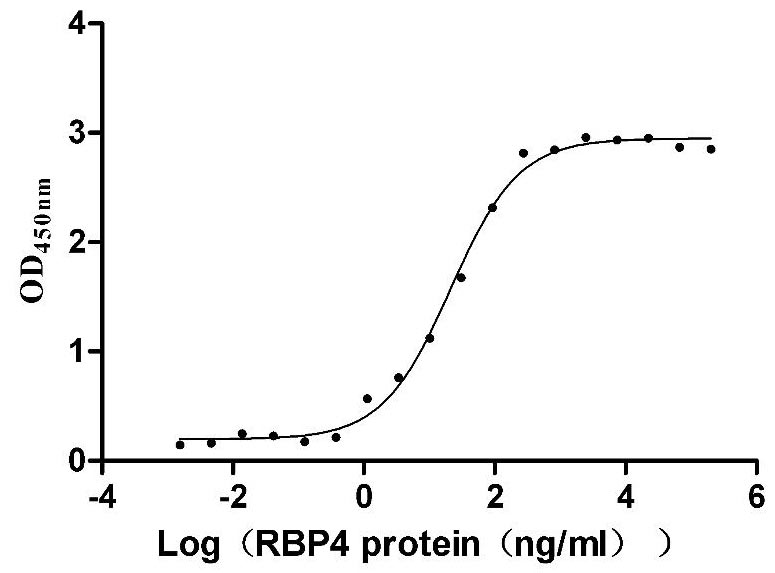Recombinant Rat Pituitary adenylate cyclase-activating polypeptide (Adcyap1)
-
中文名称:Recombinant Rat Pituitary adenylate cyclase-activating polypeptide(Adcyap1),Yeast
-
货号:CSB-YP001346RA
-
规格:
-
来源:Yeast
-
其他:
-
中文名称:Recombinant Rat Pituitary adenylate cyclase-activating polypeptide(Adcyap1),Yeast
-
货号:CSB-EP001346RA
-
规格:
-
来源:E.coli
-
其他:
-
中文名称:Recombinant Rat Pituitary adenylate cyclase-activating polypeptide(Adcyap1),Yeast
-
货号:CSB-EP001346RA-B
-
规格:
-
来源:E.coli
-
共轭:Avi-tag Biotinylated
E. coli biotin ligase (BirA) is highly specific in covalently attaching biotin to the 15 amino acid AviTag peptide. This recombinant protein was biotinylated in vivo by AviTag-BirA technology, which method is BriA catalyzes amide linkage between the biotin and the specific lysine of the AviTag.
-
其他:
-
中文名称:Recombinant Rat Pituitary adenylate cyclase-activating polypeptide(Adcyap1),Yeast
-
货号:CSB-BP001346RA
-
规格:
-
来源:Baculovirus
-
其他:
-
中文名称:Recombinant Rat Pituitary adenylate cyclase-activating polypeptide(Adcyap1),Yeast
-
货号:CSB-MP001346RA
-
规格:
-
来源:Mammalian cell
-
其他:
产品详情
-
纯度:>85% (SDS-PAGE)
-
基因名:Adcyap1
-
Uniprot No.:
-
别名:Adcyap1Pituitary adenylate cyclase-activating polypeptide; PACAP) [Cleaved into: PACAP-related peptide; PRP-48); Pituitary adenylate cyclase-activating polypeptide 27; PACAP-27; PACAP27); Pituitary adenylate cyclase-activating polypeptide 38; PACAP-38; PACAP38)]
-
种属:Rattus norvegicus (Rat)
-
蛋白长度:Cytoplasmic domain
-
表达区域:81-128
-
氨基酸序列DVAHEILNEA YRKVLDQLSA RKYLQSMVAR GMGENLAAAA VDDRAPLT
-
蛋白标签:Tag type will be determined during the manufacturing process.
The tag type will be determined during production process. If you have specified tag type, please tell us and we will develop the specified tag preferentially. -
产品提供形式:Lyophilized powder
Note: We will preferentially ship the format that we have in stock, however, if you have any special requirement for the format, please remark your requirement when placing the order, we will prepare according to your demand. -
复溶:We recommend that this vial be briefly centrifuged prior to opening to bring the contents to the bottom. Please reconstitute protein in deionized sterile water to a concentration of 0.1-1.0 mg/mL.We recommend to add 5-50% of glycerol (final concentration) and aliquot for long-term storage at -20℃/-80℃. Our default final concentration of glycerol is 50%. Customers could use it as reference.
-
储存条件:Store at -20°C/-80°C upon receipt, aliquoting is necessary for mutiple use. Avoid repeated freeze-thaw cycles.
-
保质期:The shelf life is related to many factors, storage state, buffer ingredients, storage temperature and the stability of the protein itself.
Generally, the shelf life of liquid form is 6 months at -20°C/-80°C. The shelf life of lyophilized form is 12 months at -20°C/-80°C. -
货期:Delivery time may differ from different purchasing way or location, please kindly consult your local distributors for specific delivery time.Note: All of our proteins are default shipped with normal blue ice packs, if you request to ship with dry ice, please communicate with us in advance and extra fees will be charged.
-
注意事项:Repeated freezing and thawing is not recommended. Store working aliquots at 4°C for up to one week.
-
Datasheet :Please contact us to get it.
靶点详情
-
功能:Binding to its receptor activates G proteins and stimulates adenylate cyclase in pituitary cells. Promotes neuron projection development through the RAPGEF2/Rap1/B-Raf/ERK pathway. In chromaffin cells, induces long-lasting increase of intracellular calcium concentrations and neuroendocrine secretion. Involved in the control of glucose homeostasis, induces insulin secretion by pancreatic beta cells.
-
基因功能参考文献:
- Study suggest that differently polarized macrophages could affect the growth and viability of neural stem/progenitor by regulating the expression of pituitary adenylate cyclase-activating polypeptide. PMID: 28751044
- Results suggest that exercise therapy possibly involves pain relief in SNL rats by suppressing Rnf34 and Pacap expression in the spinal cord. PMID: 28902127
- the protein and mRNA expression of pituitary adenylate cyclase-activating polypeptide-related receptors (PAC1, VPAC1, and VPAC2) in the trigeminal ganglia and trigeminal nucleus caudalis to identify changes associated with repetitive applications of chemical dural stimulations. PMID: 28776455
- results suggest that repeated exposure to stressors may differentially alter the neural circuits underlying the responses to intra-Bed Nucleus Stria Terminalis PACAP, and may result in different anxiety-like responses in males and females. PMID: 28106040
- Observations suggest that the hypothalamic peptides pituitary adenylate cyclase-activating polypeptide, kisspeptin, and gonadotropin-releasing hormone are interrelated and maintain placental functions. PMID: 26880766
- Data suggest that chronic pain-induced pituitary adenylate cyclase-activating polypeptide neuroplasticity and signaling in spinoparabrachioamygdaloid projections have an impact on central nucleus of the amygdala stress- and nociception-associated maladaptive responses, which can be ameliorated upon receptor antagonism even during injury progression. PMID: 28057459
- Our data are the first to shed light on PACAP as a secretagogue regulating a sustained production of morphogens, which in turn could enable PACAP to serve as a mitogen for retinal cells, to induce ganglion cell differentiation, and to contribute to RPE development. PMID: 28125843
- The results of this study showed that hypothalamic PACAP mRNA expression decreased during development in both male and female rats. PMID: 27181029
- These results strongly support the concept that while cAMP signaling can accelerate the degradation of Pacap mRNA, it can also synergistically enhance Ca(2+) signaling-induced transcriptional activation of Pacap PMID: 27383213
- findings indicate that PACAP and VIP can prevent the deleterious effect of Oxygen/Glucose Deprivation on rat neuronal cells. PMID: 25712659
- results indicated that in the CA1 region of hippocampus, PACAP participates in the consolidation and extinction of the contextual fear conditioning (CFC), and in the BLA, PACAP participates only in the consolidation of the CFC. PMID: 25490058
- PACAP38 stimulation of hippocampal cultures increased phosphorylation of S845, and decreased phosphorylation of T840 on the GluA1 AMPAR subunit. PMID: 25964356
- Results suggest that PACAP is a component of the parabrachioamygdaloid pathway and that PACAP/PAC1 receptor signaling in the central nucleus of the amygdala elicits nociceptive and behavioral responses PMID: 24998751
- endogenous injury-associated BDNF expression is critically involved in induction, but not maintenance, of injury-associated PACAP expression in sensory and motor neurons PMID: 24968020
- TNF is constitutively expressed in PC12 cells in a manner dependent on NF-kappaB transcription factor, and that PACAP rapidly inhibits TNF expression and secretion PMID: 24928446
- Results indicate that dopamine 2 receptor signaling regulates pituitary adenylate cyclase-activating polypeptide (PACAP) expression under physiological conditions. PMID: 24823390
- The activity of the intrapituitary PACAP-PAC1 system is regulated via the complex interaction of gonadal steroids and hypothalamic GnRH. PMID: 23690336
- These data demonstrate that androgen stimulates PACAP gene expression in the pituitary gonadotrope via direct binding of Androgen receptor to a specific cluster of evolutionarily conserved hormone response elements in the proximal rPACAP gene promoter. PMID: 23798575
- PACAP-positive nerve fibers appeared in close proximity to PAC1-positive osteoblasts, afrer tooth luxation. PMID: 23801193
- Stress peptide PACAP engages multiple signaling pathways within the carotid body to initiate excitatory responses in respiratory and sympathetic chemosensory afferents. PMID: 23594614
- PACAP promotes both survival and neuritogenesis in PC12 cells by activating NF-kappaB pathway, most likely via classical and alternative signaling cascades involving ERK1/2 kinases, Ca(2+), and c-Rel/p52 dimers. PMID: 23564451
- Acetaminophen treatment upregulates VEGF, PEDF and PACAP in brain endothelial cells exposed to oxidative stress PMID: 22944728
- PACAP induced differentiation-like phenomena in sensory neurons in a cAMP-, PKA-, ERK kinase-, & p38 kinase-dependent manner. PACAP may rescue damaged sensory neurons or switch their neuronal phenotype. PMID: 22418790
- The PACAP binding to its receptor could activate the PKA signaling pathway leading to an increased carotid body excitability under hypoxic conditions. PMID: 23080176
- An endogenous PACAP-mediated ADNP signaling system increases malignant peripheral nerve sheath tumor cell resistance to hydrogen-peroxide-induced death upon serum starvation. PMID: 22454142
- PACAP38 is involved in the modulation of dendritic spine morphology in hippocampal neurons; the ADAM10-N-cadherin signaling pathway plays a crucial role in this modification of the excitatory glutamatergic synapse. PMID: 22328515
- both VPAC1 and VPAC2 could have roles at all stages of retinal development, that PACAP acts through a specific set of PAC1 isoforms, and that Hip and Hop1 are predominantly involved in the postnatal development of rat retina. PMID: 23099490
- PACAP signaling to the STC1 gene proceeds through the extracellular signal-regulated kinases 1 and 2(ERK1/2) but not through the cAMP-dependent protein kinase (PKA). PMID: 21975601
- The selective increases in both forms of PACAP in the trigeminal nucleus caudalis suggest its important role in the central sensitization involved in migraine-like headache. PMID: 22245521
- PACAP, acting as a local ovary regulator, was closely related to the maintenance of medium-term and late pregnancy. PMID: 21038678
- PACAP was localized in/close to the cell membrane, but not in the satellite glial cells if tge sphenopalatine ganglion PMID: 22108610
- The brain melanocortin system might play a key role in control of thermogenic sympathetic outflows and digestive parasympathetic outflow by PACAP. PMID: 21291921
- PACAP and VIP induce morphological and functional differentiation of embryonic stem cells into a neuronal phenotype PMID: 22001490
- PACAP stimulates the release of tissue plasminogen activator which promotes cerebellar granule cell survival by a mechanism dependent upon its proteolytic activity. PMID: 21919910
- Investigation of the neuroprotective effect of PACAP in 8-day-old rats provides the first evidence that PACAP blocks the deleterious effects of ethanol on cerebellar development. PMID: 20422475
- The pattern of expression of PACAP in the testis and epididymis suggests a possible role of PACAP in spermatogenesis and sperm maturation. PMID: 21674129
- PACAP and its type I receptor are endogenously present in the kidney. PMID: 21620115
- dynorphin 1-17 release is tonically inhibited by PACAP and that blocking this inhibition, which increases the spinal release of Dyn, results in antinociception. PMID: 20974701
- data demonstrate that PACAP is a potent protective agent against ethanol-induced neuronal cell death PMID: 11972030
- PACAP is a cell-extrinsic regulator with multiple roles during retinal development, including the regulation of proliferation in a subpopulation of retinal progenitor cells. PMID: 20646049
- PACAP induces a robust phosphorylation of stathmin 1 in a time-dependent manner. On the other hand, PACAP decreases stathmin 1 gene expression. PMID: 20569302
- The interplay between IFNgamma released from immune cells and PACAP is of importance in brain inflammation and may affect the regeneration and recruitment of neural progenitor cells in immune diseases PMID: 20559421
- Pituitary adenylate cyclase activating polypeptide (PACAP) stimulates nNOS translocation mediated by protein kinases PKA and PKC via PACAP-specific receptor in pheochromocytoma cells. PMID: 18331476
- The presence and co-localization of vesicular glutamate transporter 2 and PACAP in retinal ganglion cell and their projections in the brain, is described. PMID: 20339872
- altered PACAP and SDF-1 gene expression in granule cells plays a role in regulated neurogenesis after global ischemia PMID: 19647005
- expression in gastric and colonic myenteric neurons; neuronal localization supports a role in the neural regulation of gastric acid secretion and gastrointestinal motor function PMID: 11959368
- plays an important role in the regulation of nNOS activity through PAC1 receptor in PC12 cells PMID: 12031689
- data suggest that TTF-1 plays an important regulatory role in the gene transcription for pituitary adenylate cyclase-activating polypeptide PMID: 12122016
- The PAC1(null) isoform and a variant containing a single 28-amino acid insert in the third intracellular (IC3) loop (hop1/2) were detected. No other IC3 variants were detected in the suprachiasmatic nucleus at any time of day. PMID: 12399105
- acute stress resulted in the activation of DARPP-32 neurons, which were innervated by PACAP-ir neuronal structures in the extended amygdala PMID: 12409216
收起更多
-
亚细胞定位:Secreted.
-
蛋白家族:Glucagon family
-
数据库链接:
KEGG: rno:24166
STRING: 10116.ENSRNOP00000063920
UniGene: Rn.202559




















